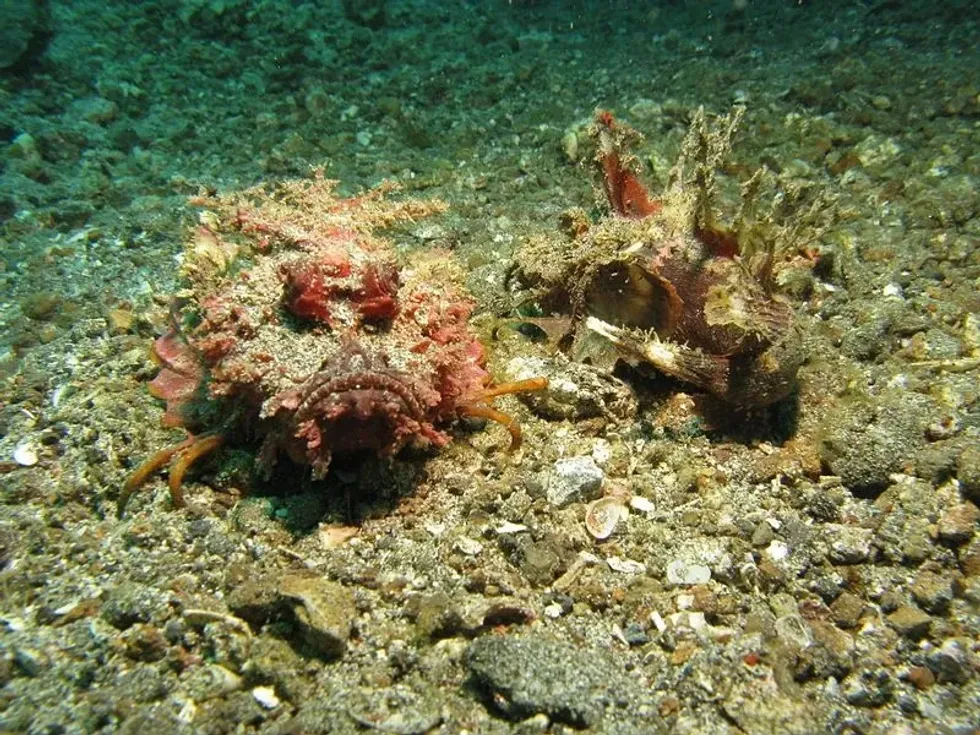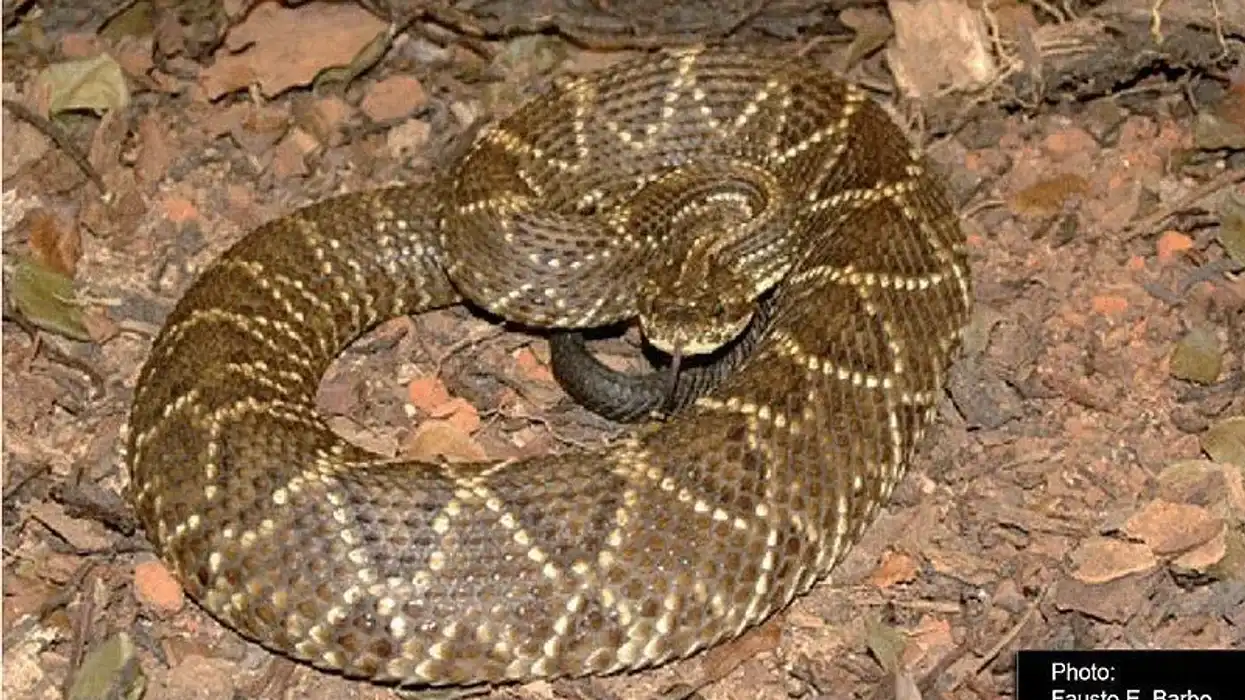The devil scorpionfish (Scorpaenopsis diabolus), also known as the false stonefish is a carnivorous ray-finned discovered in the Indo Pacific Oceans, South Pacific, and the Red Sea.
Their dorsal fin has around 12 venomous spines. Scorpaenopsis diabolus has a humped back, broad mouth, large head, and a tapering body.
They are a master at camouflaging themselves and owing to their large head size, they merge with the landscape and reef very easily.
The body of the false stonefish is grey with reddish-brown and white patches while the inner side of the pectoral fins is orange, black, and white. The family Scorpaenidae comprises the most poisonous species that is particularly evident from its name Scorpion which refers to the type of sting that is coated with poisonous mucous.
There are almost 25 species of scorpionfish in Hawaii, and some of the species are responsible for divers and snorkelers getting stung accidentally.
Are you already intrigued? Then keep reading this article as interesting facts about the devil scorpionfishes are stated below.
If you like this article then you would definitely like our articles on rockfish and rainbow trout so check them out and learn new things about different animals.
Devil Scorpionfish Interesting Facts
What type of animal is a devil scorpionfish?
The extremely good camouflaged fish with venomous spines which is hard to identify amongst the reef, stone, and coral is the devil scorpionfishes. They are also labeled as false stonefish.
What class of animal does a devil scorpionfish belong to?
The false stonefish belongs to the class of Actinopterygii which is the class of bony fishes, and the Scorpaenidae family which encompass over a hundred species and subspecies. Scorpaenidae fishes are oftentimes confused with the Scorpaenichthys that belong to a distinct family but are related.
How many devil scorpionfishes are there in the world?
The false stonefish is distributed across the Indo Pacific and the Red Sea, however, the exact number of these fishes present in the world is not known.
Where does a devil scorpionfish live?
The geographical distribution of the false stonefish comprises the regions covering Indo Pacific, South Pacific along with the Red Sea. They can be discovered near Japan, French Polynesia, Hawaii, New Caledonia, Australia, East Africa, and South Africa.
What is a devil scorpionfish's habitat?
The tropical water of Indo Pacific, South Pacific, and the Red Sea is the ideal devil scorpionfish habitat. Discovered at the depth of 230 ft (70 m), this species of fish spent the majority of its life on the ocean floor always motionless, and camouflage itself amongst the reefs for protection.
Who do devil scorpionfishes live with?
The spiny devil scorpionfish is primarily a solitary ambush predator and occasionally it is found in pairs.
How long does a devil scorpionfish live?
The average devil scorpionfish lifespan is not studied.
How do they reproduce?
There is not adequate data about the reproduction process or the offspring of the scorpionfishes. They are known to be oviparous. Males and females release their sperm and eggs simultaneously. The larvae float near the surface of the water.
What is their conservation status?
The Conservation Status of Scorpaenopsis diabolus is of Least Concern according to the IUCN (International Union for Conservation of Nature) Red List. This species of fish is a bottom dweller of the tropical water with an excellent gift of camouflage hence difficult to spot or being preyed on by other marine creatures.
Devil Scorpionfish Fun Facts
What do devil scorpionfishes look like?
Scorpaenopsis diabolus that dwells in tropical water is an ambush predator that is usually not very large and has a body length of 12 in (30 cm) known for its scorpion-like sting this fish can be dangerous.
The dorsal and anal fins have 12 spines and three to five spines respectively when threatened these fishes raise their spines attached to their back.
The body is reddish-brown, frequently mottled with grey and white which assists them to hide amongst the coral, stones, and reefs.
The body is partially covered with sediments which provides them with a stone-like appearance under the ocean just like the true stonefish. However, they are different from the true stonefish as they have an infrequently large upturned face.
It is considered to be the largest among the humpback scorpionfish as it has an extraordinary hump on its back and a wide mouth.
The head is also large and usually has an edged snout. The inner color of the pectoral fins can vary from orange to yellow and the skin is rough.

How cute are they?
Just like anglerfish, devil scorpionfishes are not cute as they have rough and spikey skin with a big head. The spines present on their back are raised when threatened is not cute at all.
How do they communicate?
These fishes are usually solitary and sometimes they can be seen in pairs, however, not much has been documented about their method of communication other than that they usually display their pectoral fins and raise their spines along their back when they feel threatened or detect other marine predators near them.
How big is a devil scorpionfish?
The length of these fishes is approximately 12 in (30 cm) that enables hiding amongst reef and coral easier. They are acknowledged as the largest humpback scorpionfish however they can be of the same size or slightly small than the reef stonefish which has a length of 12-16 in (30-40 cm).
How fast can a devil scorpionfish swim?
The speed of this marine species is not known.
How much does a devil scorpionfish weigh?
The weight is not known.
What are the male and female names of the species?
There are no distinct male and female name of the species.
What would you call a baby devil scorpionfish?
Young fishes are known as fry.
What do they eat?
The devil scropionfishes are ambush predators that wait motionless for their prey to arrive and it does not swim around and search for its prey. The prey is primarily small fish that can be found in its habitat. Devil scorpionfishes quickly lunge on its prey and devour it in seconds.
Are they dangerous?
Yes, they are very dangerous particularly to swimmers and divers because of the poisonous spines on their backs.
Would they make a good pet?
The devil scorpionfish sting is not as deadly or life-threatening as the other species of stonefish, nonetheless, they are venomous and require a distinct habitat that cannot be created in an aquarium hence they do not make a good pet.
Did you know...
Devil scorpionfishes usually demonstrate biofluorescence, which enables intraspecific communication. Biofluorescence in the false stonefish can be described as a mechanism where the fish radiates red light when illuminated by ultraviolet or blue light.
The Hawaii devil scorpionfish although venomous yet not potentially fatal as the Japanese devil scorpionfish. When accidentally touched, it causes intense pain and swelling.
Why is a devil scorpionfish also called false stonefish?
Scorpaenopsis diabolus is a member of the family Scorpaenidae which consists of primarily bottom dwellers, and an expert in camouflaging themselves. The name stonefish is derived from the fundamental attribute of the Scorpaenopsis diabolus that is staying still on the ocean floor, scarcely being noticed which resembles the true stonefish.
These species of fish are partially masked with sediments which gives them a stone-like appearance under the ocean like the true stonefishes.
However, it is not a true stonefish as it belongs to a different family hence false stonefish.
The manifestation of this fish functions like its defense mechanism and keeps itself protected from other marine creatures. Even though the members are related yet there are specific characteristics of the false stonefishes that distinguish it from the rest of the stonefishes like the shape of its body, protruding large eyes, and distinct jaw.
What survival mechanisms do devil scorpionfish have?
There are multiple survival mechanisms that the false stonefishes undertake to defend themselves and its offsprings. Their survival mechanisms include the elementary physical structure, the twelve venomous spines, and ten soft rays these spines inflict injury to their potential predators or nearby threats.
The spines of false stonefishes contain venom but it is not as deadly as the venom of reef stonefish of the Synanceiidae family.
They can camouflage within the reefs, stones, and coral so that they are difficult to detect. The unique pectoral fins have black, white, and orange blotches which they flash as a sign of warning.
Here at Kidadl, we have carefully created lots of interesting family-friendly animal facts for everyone to discover! For more relatable content, check out these Siamese fighting fish facts and cuttlefish facts pages.
You can even occupy yourself at home by coloring in one of our free printable Devil scorpionfish coloring pages.










